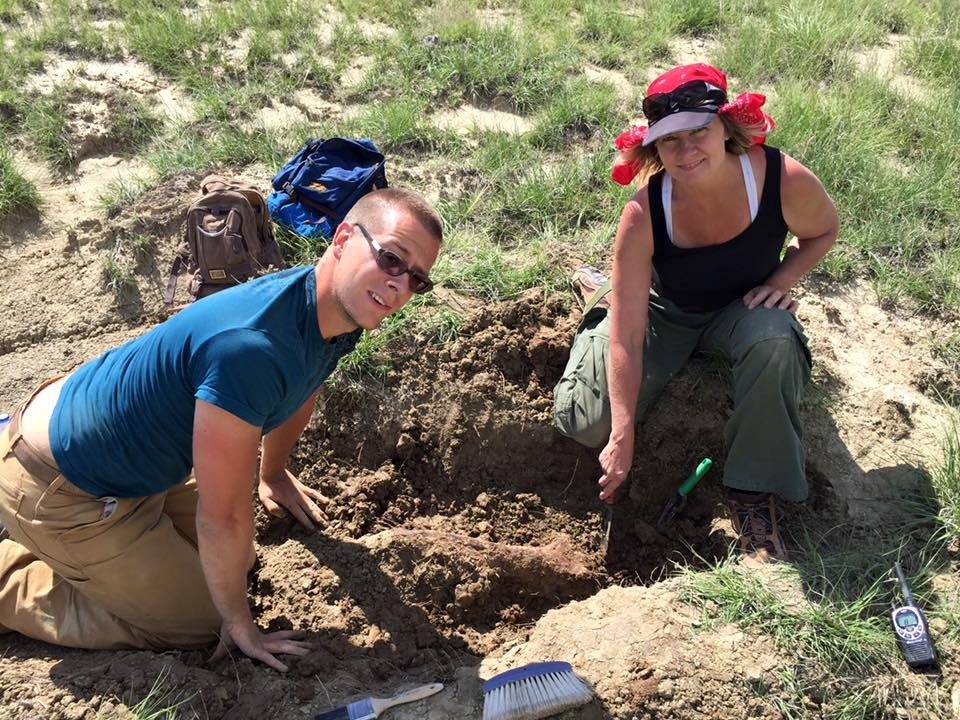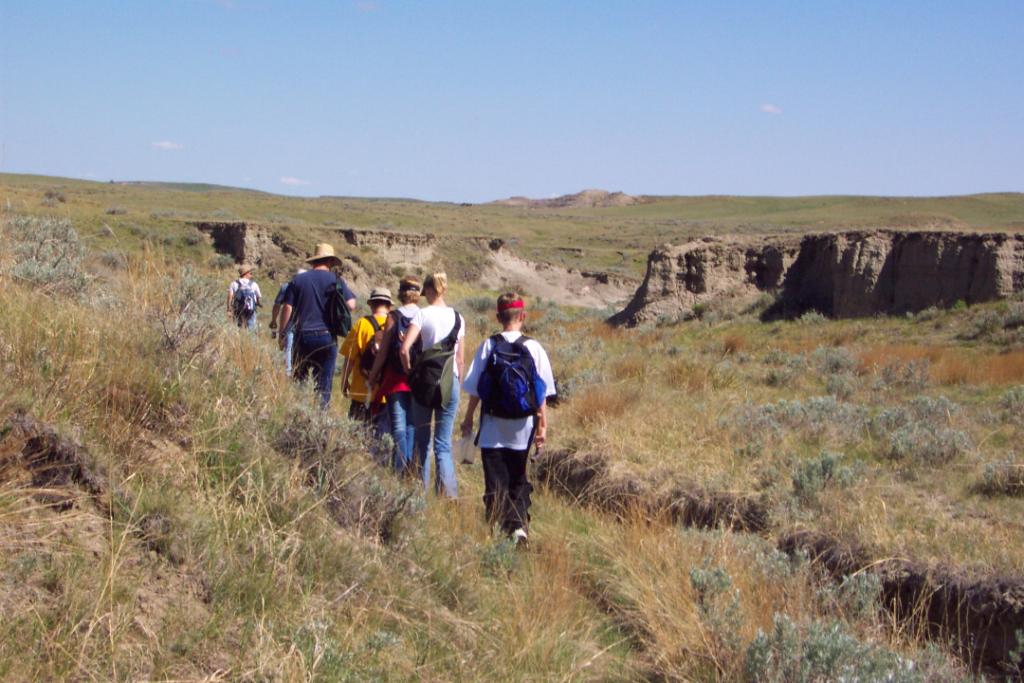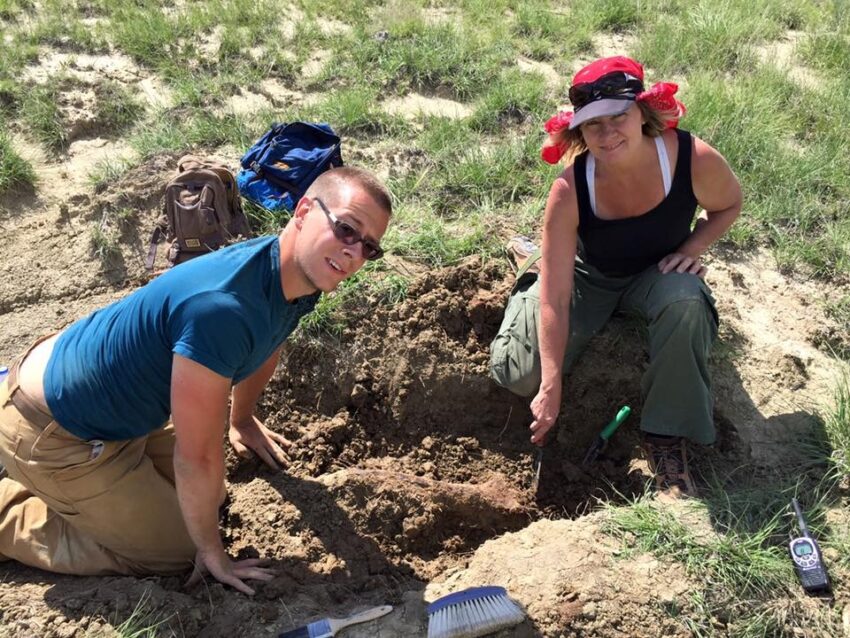By Mary Fairchild 2015, New Castle, Wyoming.
2015, New Castle, Wyoming.
When dinosaurs walked the earth, a vast inland sea had covered the area from Canada to the Gulf of Mexico.
Today, our families can walk the earth and uncover the very paths of the dinosaurs through trips with Dr. Steve Nicklas of Paleo Prospectors. For the past several years my husband and son have been able to return faithfully to Wyoming sites with great anticipation. They love to prospect and uncover what is surfacing among these bluffs. Each year brings a new thrill as well as pleasant memories of the years go by.
In 2011, there were 11 ranches in the South Dakota and Wyoming area that allowed dinosaur bone hunting through Dr. Steve Nicklas’ “Paleo Prospectors“, a company which enables families to participate in paleontological field surveys and excavations. In 2016, a new ranch was offered for hunting in the New Castle, Wyoming, area that has not been hunted before.
 Our family at a South Dakota ranch in 2002.
Our family at a South Dakota ranch in 2002.
Over 150,000 acres offer excellent exposures from Middle Cretaceous to Late Cretaceous with most ranches being in the Hell Creek and Lance Creek Formations located in South Dakota, North Dakota, and Wyoming.
There are places on the ranches that we know have been good to us and have been worth re-visiting. Ideally, you find a nice size chunk of bone and begin to probe and stab around to see where chunks are still buried. We like to use extra-long, slender screw drivers for this. Sometimes, you can also come across a discovery that has just weathered out and is sitting right on top ready to be picked up.
My son, Aaron, and husband Jim discovered a triceratops brow horn under a sage bush at the bottom of a bluff on his first day out in 2011 (slideshow above). After carefully combing the area for any other pieces of it or even pieces of the skull from which it came, it wasn’t long before they came across a nose horn from the same animal.
The job was made difficult due to the fact that the sandstone in the area closely resembled the bone. Both the bone and the sandstone were speckled with lichen as well making it often hard to decipher bone from sandstone. This slowed down their progress some.
That night, back in their room, they where able to piece together the larger fragments of one nice brow horn. On their second day, they hit the “back 9” site which we refer to as, “Aaron Hill.” This is where Aaron found a perfect nano-tyrannosaurus claw two years ago. This year, however, it appeared as if the area had been heavily picked over already.
In the afternoon the guys drove about a half a mile down the road where Rob Sula, one of the guides, was working on excavating something he had found the week prior. Aaron immediately found a very weathered piece of bone nearby. He began to probe and found the area where the bone fragments were coming from. Since Jim had the tools in his backpack he stayed and worked the area while Aaron continued on to another site.
Soon, it was made evident that Aaron had found a large limb bone that was very badly weathered. About a foot and a half deep into the hill the quality of the half buried bone began to improve. They ran out of time for the day so they had to head back to the motel…. sweet dreams….
On the third day they used a shovel on the over-burden. After about an hour of digging, Aaron chose to travel on to discover other sites while Jim continued to work this one (uncover, brush, glue, stabilize and pedestal the bone.).
It wasn’t long before Aaron radioed Jim that he had found another horn! Without tools on him he could only mark the spot. He came back and helped Jim with their, now identified, triceratops humerus (front leg). They excavated the soil around it until it was on a pedestal of dirt. As they rolled it it broke in two because it was badly weathered. They wrapped it in foil and sealed it with duct tape for the trip home.
Next, they returned to Aaron’s marked site down a bluff. As they probed around they found small pieces of bone. Aaron traveled down a gully to where he had found pieces that had washed down about forty feet away. Jim also found a large slab of conglomerate that had bone fragments, clams, gastropods, and gar fish scales. Rob Sula had reported finding a claw and teeth in a similar conglomerate earlier in the week, but they were not so lucky.
Day four began at an area nick-named “bone yard” due to a large amount of dead cow bones that were there. Steve Nicholas and his students were nearby working on a large triceratops that Aaron had discovered just last year. Most likely it will be fully excavated by the end of next summer’s session and will be off to a museum. Large and unusual finds are donated to museums on these trips for obvious reasons–to share with everyone!
On their last day, day five, they were on their way back to re-investigate the conglomerate when Aaron found an interesting area about half way down the bluff. Bone fragments soon led to a very well-preserved piece of frill sticking out of the sandstone. There was also a large plant stem and tree-like material in a conglomerate.
Underneath a ledge on a steep incline, Aaron found a triceratops frill that was exposed in some shale directly under the conglomerate. When they got it out and flipped it over, they found the tip of the horn. They determined it was the tip of the horn of the large bone they had found earlier. It was about four inches long and preserved more of the tip. Usually the first thing that gets broken up or weathered away is the tip. They had the base and the tip, both in rock, but could not find the middle.
Related
3. Black Hills Museum of Natural History
4. Mid-America Paleontology Society Annual Fossil Show Moves to Iowa
5. Watertrails Reveal Rich Archaeological History in the Midwest

